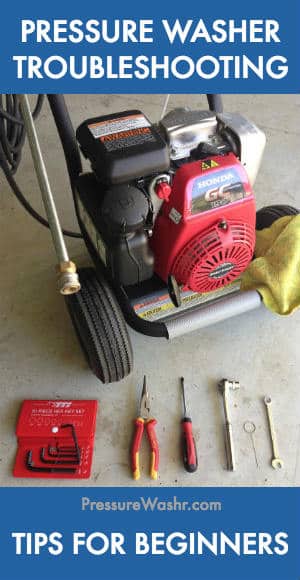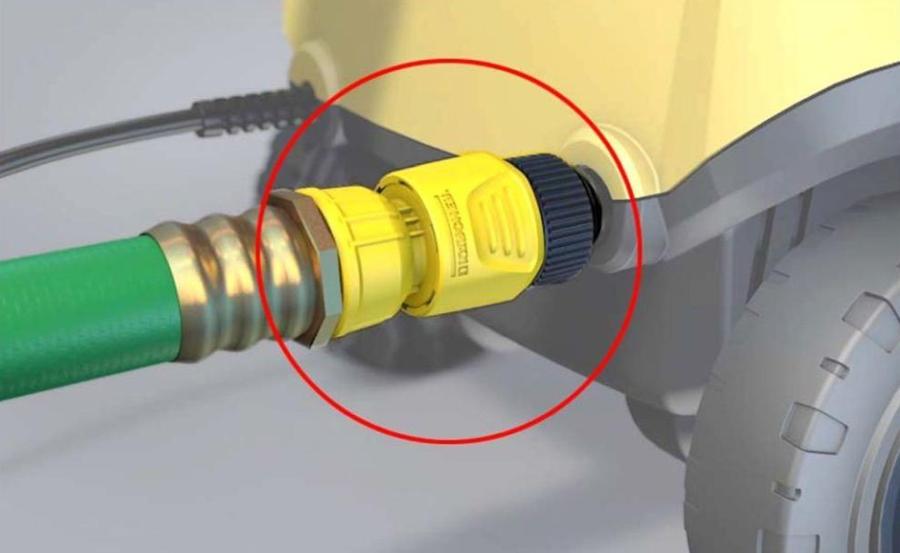If you have a pressure washer that suddenly loses pressure, there are a few things that could be the problem. The most common reason for a pressure washer to lose pressure is because the pump isn’t primed. This means that there is no water in the pump and it can’t create enough pressure to push the water through the hose.
To prime the pump, you’ll need to add water to it and then turn on the power.
Another reason why your pressure washer may be losing pressure is because of a clog in the hose or nozzle. If there is something blocking the flow of water, it can reduce the amount of pressure that comes out of the hose.
To clear a clog, you’ll need to remove whatever is blocking the flow of water and then flush out the system with clean water.
Finally, if your pressure washer has been sitting for awhile without being used, it’s possible that some of the seals have dried out and need to be replaced. This is usually an easy fix and just requires replacing some O-rings or gaskets.
If your pressure washer starts to lose pressure, there are a few things you can check before calling a technician. First, check the inlet water supply to see if it is turned on all the way. If not, turn it on until water flows freely.
Next, check the high-pressure hose for any kinks or blockages. If you find any, unkink or remove the obstruction and try again. Finally, check the pump itself for any cracks or leaks.
If you find any damage, replace the pump with a new one.
Power Washer Loses Pressure Intermittent
If your power washer loses pressure intermittently, there are a few possible causes. First, check the pump to see if it is priming properly. If the pump isn’t priming, that’s likely the problem and you’ll need to replace it.
Another possible cause is a leak in the system somewhere. Check all of the hoses and connections for leaks. If you find a leak, tighten or replace the connection as needed.
Finally, if neither of those solutions fixes the problem, it could be an issue with the unloader valve. The unloader valve regulates water flow and pressure in the power washer. If it’s not working properly, it can cause intermittent loss of pressure.
You’ll need to take your power washer to a repair shop to have this fixed.
New Pressure Washer No Pressure
If you’ve recently bought a pressure washer and it’s not working as expected, there are a few things you can check. First, make sure that the water supply is turned on and that there’s enough water pressure. Next, check the nozzle to ensure it’s properly attached and that there isn’t any blockage.
Finally, if all else fails, consult the owner’s manual or contact customer service for troubleshooting assistance.
Ryobi Pressure Washer Losing Pressure
If your Ryobi pressure washer is losing pressure, there are a few possible causes. First, check the pump for any leaks. If the pump is leaking, it will need to be replaced.
Another possible cause is a clogged filter. The filter can become clogged with dirt and debris over time, and will need to be cleaned or replaced. Finally, make sure that all of the hose connections are tight and not leaking.
If you have checked all of these things and the pressure washer is still not working properly, you may need to take it to a repair shop.
Karcher Pressure Washer Losing Pressure
Are you having issues with your Karcher pressure washer losing pressure? If so, you’re not alone. This is a common problem that can be caused by a few different things.
In this blog post, we’ll go over some of the most likely causes of this issue and how to fix them.
One of the most common causes of pressure washer loss is a dirty filter. If your machine’s filter is clogged, it can restrict water flow and cause the pump to work harder than it needs to.
This can lead to decreased performance and eventually, loss of pressure. To clean your machine’s filter, simply remove it and rinse it off with water. You may need to use a brush to remove any stubborn dirt or debris.
Another possible cause of pressure loss is an air leak in the hose or wand assembly. Over time, these seals can wear out and allow air to enter the system, which reduces pressure. Inspect your hose and wand for any cracks or leaks and replace any damaged parts as needed.
If you’ve checked both the filter and hose/wand assembly but are still experiencing issues, there could be something wrong with the pump itself. Unfortunately, this is not something that can be easily fixed at home and will likely require professional service. However, if you think this may be the issue, take note of any other symptoms you’re experiencing (e.g., strange noises) so that you can describe them to a technician accurately.
Honda Pressure Washer Troubleshooting Problems
If you’re having trouble with your Honda pressure washer, there are a few things you can do to troubleshoot the problem. First, check the oil level in the engine. If it’s low, add more oil until it reaches the full mark on the dipstick.
Next, check the air filter and clean or replace it if it’s dirty. Finally, check the spark plug and replace it if necessary. If you still can’t get your pressure washer to start, take it to a qualified repair shop for further diagnosis.

Credit: pressurewashr.com
How Do You Fix Low Pressure on a Pressure Washer?
If your pressure washer isn’t performing as it should, there are a few things you can check to troubleshoot the issue. One common problem is low pressure. This can be caused by a variety of factors, but there are a few simple steps you can take to fix it.
First, check the nozzle to see if it’s plugged or blocked. If so, clean it out and try again. If that doesn’t work, the next step is to check the pump.
Make sure there’s no debris caught in it and that all the moving parts are free of obstruction. Once you’ve checked those two things, if the pressure is still low, it’s likely due to an issue with the hose. Check for kinks or blockages and make sure there are no leaks.
If everything looks good there, then the problem may be with the machine itself and you’ll need to consult your owner’s manual or call a technician for help.
following these simple steps should help you fix low pressure on your pressure washer quickly and get back to enjoying its powerful cleaning performance!
What is the Most Common Problem With Pressure Washers?
If you’re having problems with your pressure washer, chances are it’s due to one of these common issues.
1. Not enough pressure: This is the most common problem with pressure washers. If your machine isn’t generating enough pressure, it could be because the pump isn’t working properly, the nozzle is blocked, or there’s a leak in the system.
2. Water leaking from the pump: This is a serious problem that can damage your pressure washer. If you see water leaking from the pump, turn off the machine immediately and call a technician for help. 3. The engine won’t start: This is usually due to a problem with the spark plug or fuel line.
Check these components first before calling a technician. 4. The machine vibrates excessively: This could be caused by a loose part or an imbalanced load on the wheels. Turn off the machine and check for any loose bolts or screws before continuing use.
Why Does My Pressure Washer Keep Pulsing?
If your pressure washer is pulsing, it could be because the pump is losing prime. This means that there is air in the pump, and the pump is not able to build up enough pressure to function properly. To fix this, you need to bleed the air out of the pump.
Another reason why your pressure washer might be pulsing is because of a problem with the unloader valve. The unloader valve controls the amount of water that goes through the pump, and if it’s not working properly, it can cause pulsing. You can try cleaning or replacing the unloader valve to see if that fixes the problem.
If neither of these solutions works, then you may have a more serious problem with your pressure washer and you should take it to a repair shop.
How to Solve the Pressure Washer pressure problems
Conclusion
If your pressure washer is losing pressure, there are a few things you can check to troubleshoot the issue. First, check the intake valve to make sure it’s open and not blocked by debris. Next, check the unloader valve to see if it’s stuck in the “on” position.
If neither of these valves is the problem, then the pump may need to be replaced.

